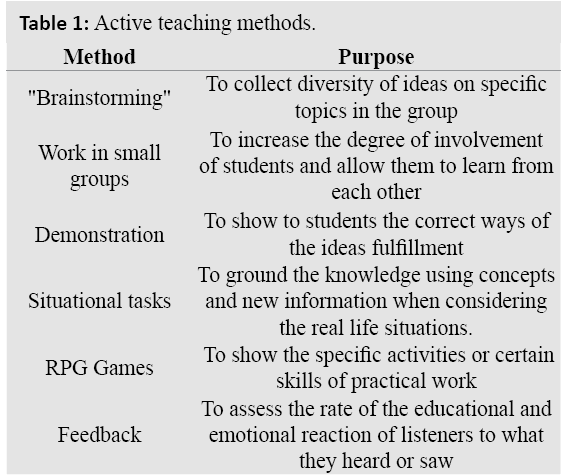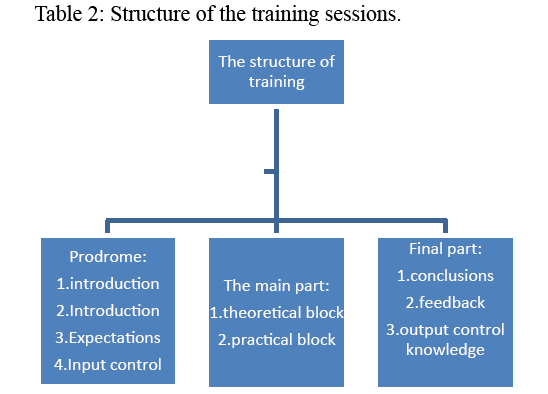Research Article - (2015) Volume 23, Issue 5
Director of Educational Research Training Center of Family Medicine and First Care, USA
Shushman I
Family Medicine and Therapy Department, Ukraine
Kedyk A
Family Medicine and Therapy Department, Ukraine
Hosam Mansour
October 6th University, 6th of October City, Giza Governorate, Egypt
Ahmed Masoud
Benha University, Banha, Al Qalyubia Governorate, Egypt
This article provides the information on the effectiveness of the training sessions in the system of the Family Doctors studies. Before the training over a third of the would be trained doctors has not reached the average level of the required knowledge on the chosen topic. Training, as a practical means of Family Doctors education proved to be almost 100% effective as to the level of the information assimilation.
training center, innovative teaching methods, training-seminar, family medicine.
According to the direction selected by Ukraine as to the primary health care it is based on the family medicine. So it became necessary to introduce innovative methods of studying including trainings. Trainings are practical seminars for family medicine doctors which significantly differ from the traditional classical format of lectures, seminars and workshops and can increase the efficiency of representation and effectiveness of practical knowledge of doctors in Ukraine.[1]
According to the international data on the effectiveness of different forms of education, the classical lecture presentation of information has the lowest percentage in assimilating knowledge, namely 5%. The most effective are teaching others (90%) and practical skills training (75%).[2]
Training seminars as a form of group work envisages the active participation and creative interaction among the members and with the tutor.
As a form of pedagogical influence training primarily involves the active methods of group work (Table 1)

The innovative active learning methods are used in order to train and develop the creative thinking the same as to create appropriate practical skills.
The training process is carefully planned to provide or replenish knowledge, testing skills, change or update certain attitudes, opinions and believes (Table 2).[2,3]

The Educational Research Training Center of Family Medicine and First Care was launched in 2013 and in a shirt time became popular among family doctors of Transcarpathian region of Ukraine due to innovative forms of practical education. Shirt-term (one day) training seminars were organized for family doctors and were aimed to increase their practical knowledge in the main important topics. Participants were able to get credits for 8 hour seminar training.
The training seminar under the name “Acute respiratory diseases and their complications - a practical approach of a family doctor” organized within the Project "Non-stop professional development and education of the Ukrainian doctors” can be a good example of such successful teaching of the family doctors. First, the participants of the training were familiarized with the structure of the training day: they were given the duration and location of the workshops and the input test on the subject of the training day. The seminar has started with the introductory lecture on the selected themes, which was not only informative but also motivational. The material was presented using the following techniques: brainstorming, work in small groups, analysis of clinical cases. Any training is implemented through the interactive learning, i.e. learning in the course of training. Thus, to improve the effectiveness of the classes all the trainees were divided into two groups, 15 people in each. The division was made not at random but by the purposeful organization of heterogeneous groups according to the age of the participants. According to the organizers’ point of view, such division allows to regard the issue both from practical and theoretical points of view. Besides, it gives the chance to share experience. Due to the coaches’ facilitation skills, they managed to level the age differences within the group, so that the participants could express their views freely. Two organized groups held the seminars on the topical issues of the respiratory diseases and their approaches to diagnosis and treatment simultaneously. The duration of the seminars was the same - 45 minutes, enabling the most effective rotation of the groups, so that every participant could alternately participate in each workshop. To reduce the intellectual load and restore mental capacity each seminar was interrupted by 5-15 minutes coffee breaks.[4,5]
With a general theme of the seminar, the methods of presentation were significantly different that increased interest and attention of the trainees. Thus, the workshop ?1 (topic "Nebulizer therapy") was conducted by the method of working in small groups. This method helps to increases the degree of involvement of students. There is always an opportunity of learning from each other and of creating a feeling of collectivity in the group. The demonstration technique was used too. Each group was given an individual problem the final solution of which was presented to the audience followed by the discussion. In order to transform the theoretical information into practical action the trainer demonstrated the technique himself teaching the trainees how to use the nebulizer. In order to consolidate the acquired knowledge and to apply it in practice, the trainees were offered the case studies close to the real life situations.
Workshop ?2 (topic: "Otoscopy in the practice of the family doctor") was held in a form of the video - photographs session with explanations and interactive reporting, which allowed the trainees not only recognize the different pathologies during otoscopy but also differentiate the diagnosis in various clinical cases. The systematization of the material helped to facilitate the assimilation of the large amount of information. Besides, the trainees had the opportunity to master the technique of otoscopy and to work out their skills on their colleagues- volunteers.
The workshops were followed by another interactive lecture “The practical approach of treating complications of the respiratory diseases", concluded by the initial testing.
The training day was concluded by the feedback to discuss the positive and negative points of the training. Everyone had the opportunity to share their experiences, suggestions and highlight points that were new and most interesting for them personally.
To evaluate the effectiveness of the training sessions and assimilated knowledge of the Family Doctors from Transcarpathian region we conducted the input and output testing. The tests included 20 questions within the studied training subjects with 4 answers, only one of which was correct. Each correct answer was evaluated as one point, so the total number of points was 20. The questions at the beginning and at the end of the training were identical.
The statistical analysis of the data, including the definition of the T-test was conducted using Microsoft Excell 2007.[6]
We managed to conduct 10 training sessions, five of which were on " Acute respiratory diseases and their complications - a practical approach of a family doctor " ( theme - 1) and five on "Metabolic syndrome in the practice of a family doctor" (theme- 2).
The total number of the trainees who participated in the test was 134, 65 people for the theme 1, and 69 for the theme 2.
The average result of the input testing for the 1 st theme was 6.5 points (32.5% correct answers) and for the 2- nd theme it was 8.2 points (41% correct answers). Thus, the level of knowledge shown by the trainees was below average even though the subject chosen for the seminar was very relevant.
The average output test result for the theme- 1 was 15.3 points (76.5% correct answers) and for the theme 2 - 13.7 points (69% correct answers, Figure 1). The level of knowledge of the trainees has increased by 44% (8.8 correct answers more), and 28% respectively (5.5 correct answers more).
The number of the trainees who correctly answered half of the test questions (received 10 or more points) for the theme - 1 input control test was 11 people (17%), while at the output test practically all the trainees have given more than half of the correct answers out of 100%.
The number of the trainees who correctly answered at least half of the input test questions for the theme - 2 was 12 people (17.4%) while at the output control 64 people received more than 10 points (92.7%). So after the trainings the knowledge of almost all the trainees was more than average (Figure 2).